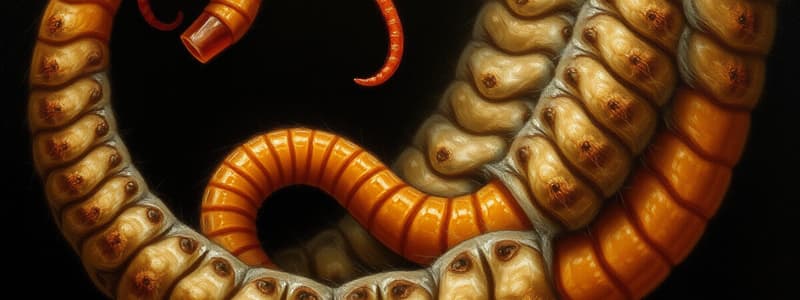Podcast
Questions and Answers
Which phylum includes roundworms?
Which phylum includes roundworms?
- Arthropoda
- Cestoda
- Nemathelminthes (correct)
- Platyhelminthes
What are the two genera of parasites discussed specifically in Chapter 5?
What are the two genera of parasites discussed specifically in Chapter 5?
- Ascaris and Flatworm
- Filariae and Cestoda
- Giardia and Entamoeba
- Leishmania and Trypanosoma (correct)
Which class of helminths is characterized by tapeworms?
Which class of helminths is characterized by tapeworms?
- Cestoda (correct)
- Trematoda
- Filariae
- Nematoda
Which of the following is NOT a group of clinically significant parasites mentioned?
Which of the following is NOT a group of clinically significant parasites mentioned?
What is the common term for the class of worms that includes flukes?
What is the common term for the class of worms that includes flukes?
What type of organisms do arthropods encompass?
What type of organisms do arthropods encompass?
Which of the following is NOT a characteristic of multicellular worms?
Which of the following is NOT a characteristic of multicellular worms?
Which term is used to refer to infections caused by Leishmania?
Which term is used to refer to infections caused by Leishmania?
Who is the Assistant Dean of Student and Academic Affairs highlighted in the acknowledgments?
Who is the Assistant Dean of Student and Academic Affairs highlighted in the acknowledgments?
Which university is mentioned in connection with both Peggy A. Edwards and Michael P. Grady?
Which university is mentioned in connection with both Peggy A. Edwards and Michael P. Grady?
What type of contributions did the listed students primarily provide?
What type of contributions did the listed students primarily provide?
What role does Eugene C. Wienke hold according to the acknowledgments?
What role does Eugene C. Wienke hold according to the acknowledgments?
Which individual is thanked for providing the opportunity to study Medical Technology?
Which individual is thanked for providing the opportunity to study Medical Technology?
In which state is Northeast Louisiana University located?
In which state is Northeast Louisiana University located?
What was primarily incorporated into the manuscript from the students’ research projects?
What was primarily incorporated into the manuscript from the students’ research projects?
Which of the following individuals is NOT mentioned in the acknowledgments list?
Which of the following individuals is NOT mentioned in the acknowledgments list?
What must practitioners and researchers rely on when evaluating information and methods?
What must practitioners and researchers rely on when evaluating information and methods?
What is emphasized as crucial for the safety of practitioners and their patients?
What is emphasized as crucial for the safety of practitioners and their patients?
Why should practitioners verify the recommended dosage and method for drug administration?
Why should practitioners verify the recommended dosage and method for drug administration?
What is the primary responsibility of practitioners regarding patient treatment?
What is the primary responsibility of practitioners regarding patient treatment?
What should practitioners be particularly cautious about regarding the methods and products they use?
What should practitioners be particularly cautious about regarding the methods and products they use?
What happens to the liability of authors and publishers in connection to the methods and products described?
What happens to the liability of authors and publishers in connection to the methods and products described?
What is indicated about knowledge and best practices in the relevant field?
What is indicated about knowledge and best practices in the relevant field?
What might necessitate a change in treatment practices according to the content?
What might necessitate a change in treatment practices according to the content?
Which class of organisms includes single-celled parasites?
Which class of organisms includes single-celled parasites?
What best describes an obligatory parasite?
What best describes an obligatory parasite?
Which of the following terms best matches a form of parasite that enters a host?
Which of the following terms best matches a form of parasite that enters a host?
What is the primary reason for the increased prevalence of parasites in nonendemic areas?
What is the primary reason for the increased prevalence of parasites in nonendemic areas?
Which of the following accurately defines commensalism?
Which of the following accurately defines commensalism?
What essential role does the study of parasitology play?
What essential role does the study of parasitology play?
What best describes the term 'disease' in the context of parasitology?
What best describes the term 'disease' in the context of parasitology?
Which of the following correctly matches a parasite with the appropriate descriptor?
Which of the following correctly matches a parasite with the appropriate descriptor?
What is the main purpose of concentration techniques in parasitology?
What is the main purpose of concentration techniques in parasitology?
Which of the following is an advantage of using a permanent stained smear?
Which of the following is an advantage of using a permanent stained smear?
When can the direct wet preparation procedure for stool samples be eliminated?
When can the direct wet preparation procedure for stool samples be eliminated?
Which method is typically used for stool screening in parasitology?
Which method is typically used for stool screening in parasitology?
What is the primary disadvantage of examining specimens other than stool for parasitic infections?
What is the primary disadvantage of examining specimens other than stool for parasitic infections?
In parasitology, how do immunologic tests help in diagnosis?
In parasitology, how do immunologic tests help in diagnosis?
Which of the following areas is not typically included in a parasitology quality assurance program?
Which of the following areas is not typically included in a parasitology quality assurance program?
What is a common disadvantage of using concentration techniques?
What is a common disadvantage of using concentration techniques?
Flashcards are hidden until you start studying
Study Notes
Parasite Classification
- Three major groups of clinically significant parasites:
- Single-celled parasites (Protozoa)
- Multicellular worms (Metazoa helminths)
- Arthropods (insects and their allies)
Helminths Overview
- Classes of helminths include:
- Nematoda (roundworms)
- Cestoda (tapeworms)
- Trematoda (flukes)
- Filariae (tissue roundworms)
Importance of Classification
- Variations of parasite names (e.g., leishmanial or trypanosomal infections) highlight the need for precise terminology.
- Knowledge of epidemiology, life cycles, and host-parasite interactions is critical for understanding parasitic diseases.
Safety and Practice
- Practitioners must rely on their experience when evaluating information on treatments and methods.
- It is essential to continually check current recommendations for drug dosages and safety procedures.
Role of Education and Knowledge
- Competent practitioners in parasitology play a vital role in identifying and managing parasites.
- Ongoing research and practice updates are necessary for effective treatment and control of parasitic infections.
Evolution of Parasitic Relationships
- Historically, some parasites considered commensal have become significant human pathogens.
- An increase in knowledge about parasite biology has improved understanding of diseases they cause.
Acknowledgments and Contributions
- Several individuals contributed significantly to the research, definitions, and illustrations related to parasitology.
- Collaborative work helps advance understanding and education in clinical laboratory science.
Special Considerations in Parasitology
- Each parasitic infection has unique transmission modes and life cycles critical for prevention.
- Understanding the infective stage of parasites is crucial for diagnosis and treatment.
Research Implications
- Applications of new diagnostic techniques continue to evolve, enhancing the effectiveness of parasite detection and treatment strategies.
- Quality assurance processes are important in laboratory settings for the accurate assessment of parasitic infections.
Studying That Suits You
Use AI to generate personalized quizzes and flashcards to suit your learning preferences.




